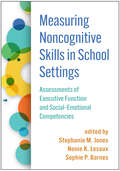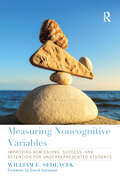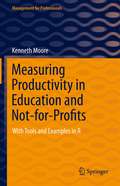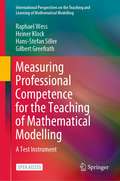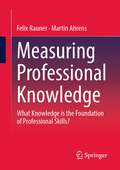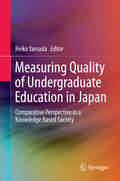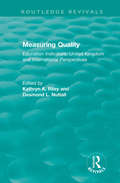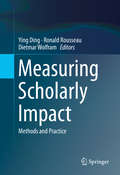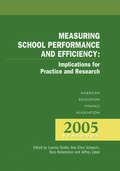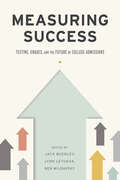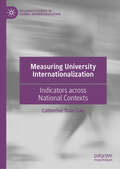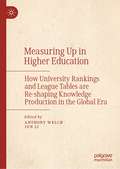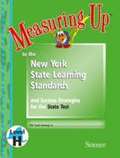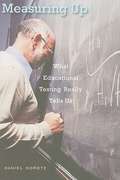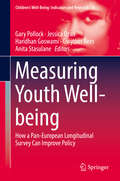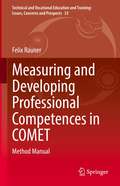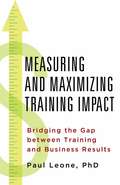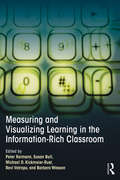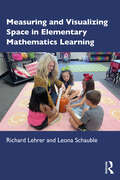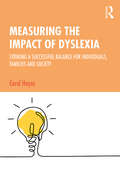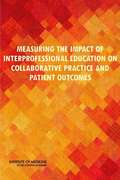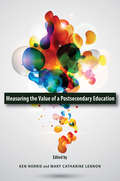- Table View
- List View
Measuring Literacy: Performance Levels For Adults
by National Research Council of the National AcademiesThe National Assessment of Adult Literacy (NAAL) is a household survey conducted periodically by the Department of Education that evaluates the literacy skills of a sample of adults in the United Stages ages 16 and older. NAAL results are used to characterize adults’ literacy skills and to inform policy and programmatic decisions. The Committee on Performance Levels for Adult Literacy was convened at the Department’s request for assistance in determining a means for booking assessment results that would be useful and understandable for NAAL’S many varied audiences. Through a process detailed in the book, the committee determined that five performance level categories should be used to characterize adults’ literacy skills: nonliterate in English, below basic literacy, basic literacy, intermediate literacy, and advanced literacy. This book documents the process the committee used to determine these performance categories, estimates the percentages of adults whose literacy skills fall into each category, recommends ways to communicate about adults’ literacy skills based on NAAL, and makes suggestions for ways to improve future assessments of adult literacy.
Measuring Noncognitive Skills in School Settings: Assessments of Executive Function and Social-Emotional Competencies
by Stephanie M. Jones, Nonie K. Lesaux and Sophie P. BarnesChildren's social–emotional and self-regulation skills are critical for success in school and, ultimately, in the workplace. How can educators determine the most effective approaches for measuring students' interpersonal competencies? And how can they use the data to improve their own practice? Relevant for school leaders, educators, researchers, and other stakeholders, this book brings together leading experts from multiple disciplines to discuss the current state of measurement and assessment of a broad range of noncognitive skills and present an array of innovative tools. Chapters describe measures targeting the individual student, classroom, whole school, and community; highlight implications for instructional decision making; examine key issues in methodology, practice, and policy; and share examples of systematic school- and districtwide implementation.
Measuring Noncognitive Variables: Improving Admissions, Success and Retention for Underrepresented Students
by William SedlacekCo-published in association with Big Picture Learning.Measuring Noncognitive Variables: Improving Admissions, Success, and Retention for Underrepresented Students is written for admissions professionals, counselors, faculty and advisers who admit, teach, or work with students during the admissions process and post-enrollment period. It brings together theory, research and practice related to noncognitive variables in a practical way by using assessment methods provided at no cost. Noncognitive variables have been shown to correlate with the academic success of students of all races, cultures, and backgrounds. Noncognitive variables include personal and social dimensions, adjustment, motivation, and student perceptions, rather than the traditional verbal and quantitative areas (often called cognitive) typically measured by standardized tests.Key Features include:* Models that raise concepts related to innovation, diversity and racism in proactive ways* Examples of admission and post-enrollment applications that show how schools and programs can use noncognitive variables in a variety of ways * Additional examples from foundations, professional associations, and K-12 programs* An overview of the limitations of traditional assessment methods such as admission tests, grades, and courses takenEducation professionals involved in the admissions process will find this guide effectively informs their practice. This guide is also appropriate as a textbook in a range of courses offered in Higher Education and Student Affairs Masters and PhD programs.
Measuring Productivity in Education and Not-for-Profits: With Tools and Examples in R (Management for Professionals)
by Kenneth MooreThis book takes the reader through real-world examples for how to characterize and measure the productivity and performance of NFPs and education institutions—that is, organisations that produce value for society, which cannot be measured accurately in financial KPIs. It focuses on how best to frame non-profit performance and productivity, and provides a suite of tools for measurement and benchmarking. It further challenges the reader to consider alternative and appropriate uses of quantitative measures, which are fit-for-purpose in individual contexts.It is true that the risk of misusing quantitative measures is ever-present. But does that risk outweigh the benefits of forming a more precise and shared understanding of what could generate better outcomes? There will always be concerns about policy and performance management. Goodheart’s Law states that once a measure becomes a target, it is no longer a good measure. This book helps to strike a meaningful balance between what can be measured, what cannot, and how best to use quantitative information in sectors that are often averse to being held up to the light and put on a scale by outsiders.
Measuring Professional Competence for the Teaching of Mathematical Modelling: A Test Instrument (International Perspectives on the Teaching and Learning of Mathematical Modelling)
by Gilbert Greefrath Hans-Stefan Siller Raphael Wess Heiner KlockThis open access book presents a structural model and an associated test instrument designed to provide a detailed analysis of professional competences for teaching mathematical modelling. The conceptualisation is based on the COACTIV model, which describes aspects, areas and facets of professional competences of teachers. The manual provides an overview of the essential teaching skills in application-related contexts and offers the tools needed to capture these aspects. It discusses the objectives and application areas of the instrument, as well as the development of the test. In addition, it describes the implementation and evaluates the quality and results of the structural equation analysis of the model. Teaching mathematical modelling is a cognitively challenging activity for (prospective) teachers. Thus, teacher education requires a detailed analysis of professional competence for teaching mathematical modelling. Measuring this competence requires theoretical models that accurately describe requirements placed upon teachers, as well as appropriate evaluation tools that adequately capture skills and abilities in this field. This book presents an instrument that measures the professional competences in a sample of 349 prospective teachers.
Measuring Professional Knowledge: What Knowledge is the Foundation of Professional Skills?
by Felix Rauner Martin AhrensIn this book, we show the replacement of academic and vocational education, which is structured according to subject systems and oriented towards scientific knowledge, by vocational action knowledge. This work process knowledge is the basis for the acquisition of the design competence of vocational specialists, which is becoming increasingly important in the world of work.A modern knowledge concept based on vocational education is developed and documented. In the first part of the book the concept of vocational knowledge is developed, in the second part empirical results from COMET projects are documented, from which the vocational knowledge imparted in different occupations can be read.There has been a confusing discussion about vocational knowledge for decades. In 1991, the KMK agreed on a new concept for vocational education and training with the guiding idea of vocational design competence. It remained open on which vocational knowledge this new guiding idea should be based. Up to now there has been no original vocational pedagogical justification for the vocational knowledge on which vocational design competence is based.
Measuring Quality of Undergraduate Education in Japan
by Reiko YamadaThis book explores how the global trend of quality assurance in higher education is related to the boom of measuring learning outcomes in Japan. It also presents a comparative study in higher education policy between Japan and the US, examining how both countries have reacted to the demands of globalization. This comparative view will help readers understand the present issues Japanese higher education faces and grasp the commonalties and differences between American and Japanese higher education. The book first explores the forces of globalization that have resulted in Japanese universities emphasizing student learning outcomes. Next, it examines how Japanese higher education has learned from the experience of the U. S. , whose higher education reform has been regarded as a model for Japan. The book explains why quality assurance for teaching and learning has become important for all Japanese higher education institutions. Higher Education on a global basis is now facing a great issue. In order to help students in a competitive global market, universities need to become more teaching-and-learning-centered and develop more internationalized curricula. This book provides comparative views for cultural and structural similarities and differences in higher education in two countries which could explain significant differences in the gains students make in college. It will help readers understand not only how student learning outcomes can be measured, but why universities throughout the world must continually strive to become world-class institutions.
Measuring Quality: United Kingdom and International Perspectives (Routledge Revivals)
by Kathryn Riley Desmond NuttallMoves to develop indicators about school effectiveness and performance have been driven by national trends and debates about performance and accountability. Nationally set indicators – such as the standard assessment tasks, or the publication of performance in public examinations – have increasingly become part of the new education currency: a medium for exercising choice and decision-making in the new education market place. As contributors to this book suggest, such a framework is not unproblematic. Originally published in 1994, this book offers a number of insights into the general debate about performance indicators at the time. It explores the background to the debate; the differing perspectives of policy-makers and practitioners; and the purpose, audiences and values of education indicators, both in the UK and elsewhere.
Measuring Scholarly Impact
by Ying Ding Ronald Rousseau Dietmar WolframThis book is an authoritative handbook of current topics, technologies and methodological approaches that may be used for the study of scholarly impact. The included methods cover a range of fields such as statistical sciences, scientific visualization, network analysis, text mining, and information retrieval. The techniques and tools enable researchers to investigate metric phenomena and to assess scholarly impact in new ways. Each chapter offers an introduction to the selected topic and outlines how the topic, technology or methodological approach may be applied to metrics-related research. Comprehensive and up-to-date, Measuring Scholarly Impact: Methods and Practice is designed for researchers and scholars interested in informetrics, scientometrics, and text mining. The hands-on perspective is also beneficial to advanced-level students in fields from computer science and statistics to information science.
Measuring School Performance & Efficiency
by Leanna Stiefel Amy Ellen Schwartz Ross Rubenstein Jeffrey ZabelThis yearbook focuses on alternative ways to measure how well schools are educating their students, delivering what parents want, and using resources efficiently.
Measuring Success: Testing, Grades, and the Future of College Admissions
by Jack Buckley, Lynn Letukas, and Ben WildavskyStandardized tests have become the gateway to higher education... but should they be?For more than seventy-five years, standardized tests have been considered a vital tool for gauging students’ readiness for college. However, few people—including students, parents, teachers, and policy makers—understand how tests like the SAT or ACT are used in admissions decisions. Once touted as the best way to compare students from diverse backgrounds, these tests are now increasingly criticized as being biased in favor of traditionally privileged groups. A small but growing number of colleges have made such testing optional for applicants.Is this the right way to go? Measuring Success investigates the research and policy implications of test-optional practices, considering both sides of the debate. Does a test-optional policy result in a more diverse student body or improve attainment and retention rates? Drawing upon the expertise of higher education researchers, admissions officers, enrollment managers, and policy professionals, this volume is among the first to investigate the research and policy implications of test-optional practices. Although the test-optional movement has received ample attention, its claims have rarely been subjected to empirical scrutiny. This volume provides a much-needed evaluation of the use and value of standardized admissions tests in an era of widespread grade inflation. It will be of great value to those seeking to strike the proper balance between uniformity and fairness in higher education. Contributors: Andrew S. Belasco, A. Emiko Blalock, William G. Bowen, Jim Brooks, Matthew M. Chingos, James C. Hearn, Michael Hurwitz, Jonathan Jacobs, Nathan R. Kuncel, Jason Lee, Jerome A. Lucido, Eric Maguire, Krista Mattern, Michael S. McPherson, Kelly O. Rosinger, Paul R. Sackett, Edgar Sanchez, Dhruv B. Sharma, Emily J. Shaw, Kyle Sweitzer, Roger J. Thompson, Meredith Welch, Rebecca Zwick
Measuring University Internationalization: Indicators across National Contexts (Palgrave Studies in Global Higher Education)
by Catherine Yuan GaoThis book investigates university internationalization in different national contexts and compares internationalization performance across national boundaries. Internationalization has been recognised by policymakers as the key to perform successfully within the new global context: the author identifies primary motivations for universities to embrace this agenda, and deconstructs the phenomenon into measurable dimensions and components. Using extensive qualitative data from university leaders and practitioners, this book analyses the global forces that shape the international education landscape, and reviews the existing instruments for measuring internationalization. In doing so, the author proposes an integrated understanding of university internationalization and indicates benchmarks that can help to quantify and measure this phenomenon. This book will be of interest and value to students and scholars of university internationalization.
Measuring Up in Higher Education: How University Rankings and League Tables are Re-shaping Knowledge Production in the Global Era
by Anthony Welch Jun LiThis book examines the quality assessment movement in academic scholarship, as globalization prompts a search for global measures of university services and output. It gauges productivity in terms of universal publication metrics, and considers ranking and research productivity from a comparative perspective. The book considers the use of the “impact factor” as a gauge of publication value, noting that this less important in countries lacking central government appropriations to universities and to research. It argues that pressure to publish in certain journals, and to research topics of interest to English language readers, has been felt differentially in English-language systems, compared to others, but also that performance pressures fall more on younger, more juniour, contract staff, than on senior and tenured professors. It problematizes international comparisons of quality, and analyses the benefits of a zone of ideas and metrics in a common language – promoting international mobility, efficiency, collaboration - but also the costs which are rarely borne equally across countries, languages and cultures. The book provides a strong, evidence-based contribution to major debates in contemporary higher education reforms and the measurement of academic output.
Measuring Up to the English I End-of-Course Exam, Texas STAAR Edition
by Peoples Education"The lessons in this English I worktext are geared towards helping you master the TEKS so that you are well prepared for the Texas STAAR End-of-Course exam. EOC English I
Measuring Up to the New York State Learning Standards and Success Strategies for the State Test: Science, Level H, Grade 8 (Measuring Up)
by Peoples Education Staff<p>Measuring Up to the New York State Learning Standards and Success Strategies for the State Test (Level H-Science). <p>This book is customized for New York and the lessons match the New York State Learning Standards. The Measuring Up program includes comprehensive worktexts and New York Diagnostic Practice Tests, which are available separately. <p>This worktext is customized to the New York Intermediate Science Core Curriculum and will help you prepare for the New York State Evaluation Test in Science for Grade 8.</p>
Measuring Up: What Educational Testing Really Tells Us
by Daniel KoretzMeasuring Up demystifies educational testing - from MCAS to SAT to WAIS. Bringing statistical terms down to earth, Koretz takes readers through the most fundamental issues that arise in educational testing and shows how they apply to some of the most controversial issues in education today, from high-stakes testing
Measuring Youth Well-being: How A Pan-european Longitudinal Survey Can Improve Policy (Children's Well-being: Indicators and Research Ser. #19)
by Gwyther Rees Gary Pollock Jessica Ozan Haridhan Goswami Anita StasulaneThis volume presents key findings from the EU funded Measuring Youth Well-being (MYWeB) project which assessed the feasibility of a European Longitudinal Study for Children and Young People (ELSCYP). It draws on the original empirical data from a panel of experts in the field of child well-being as well as field experiences from a number of European countries. MYWeB explored strategies and methodological challenges for involving children and young people in well-being research in order to fight poverty and social exclusion. It does so by evaluating different options to measure the well-being of children and young people across Europe using a child centric approach.Written by experts researching children and young people from a variety of disciplinary backgrounds in the areas of sociology, psychology, political science, education, philosophy, economics, social policy, and evaluation.
Measuring and Developing Professional Competences in COMET: Method Manual (Technical and Vocational Education and Training: Issues, Concerns and Prospects #33)
by Felix RaunerThis book is a detailed manual for the implementation of competence diagnostics in the field of vocational training. With the COMET competence model, both conceptual competences as well as practical skills are recorded and evaluated. The manual guides through all methodological steps, including the preparation and implementation of tests, cross and longitudinal studies, the development of context analyses and measurement methods for the test motivation. The focus of the final chapter is the application of the COMET procedure for the design, organisation and evaluation of vocational education and training processes.
Measuring and Maximizing Training Impact
by Paul LeoneThis book shows trainers how to create building blocks, construct the right linkages, and measure the impact of training programs from the first step (Level 1 - reaction) to the final destination (Level 5 - ROI). Including a new ground-breaking Level 6 exploring training sustainability, this is a must-read for HR professionals.
Measuring and Visualizing Learning in the Information-Rich Classroom
by Peter Reimann Barbara Wasson Michael Kickmeier-Rust Ravi Vatrapu Susan BullIntegrated information systems are increasingly used in schools, and the advent of the technology-rich classroom requires a new degree of ongoing classroom assessment. Able to track web searches, resources used, task completion time, and a variety of other classroom behaviors, technology-rich classrooms offer a wealth of potential information about teaching and learning. This information can be used to track student progress in languages, STEM, and in 21st Century skills, for instance. However, despite these changes, there has been little change in the kind of data made available to teachers, administrators, students, and parents. Measuring and Visualizing Learning in the Information-Rich Classroom collects research on the implementation of classroom assessment techniques in technology-enhanced learning environments. Building on research conducted by a multinational and multidisciplinary team of learning technology experts, and specialists from around the globe, this book addresses these discrepancies. With contributions from major researchers in education technology, testing and assessment, and education psychology, this book contributes to a holistic approach for building the information infrastructure of the 21st Century school.
Measuring and Visualizing Space in Elementary Mathematics Learning
by Richard Lehrer Leona SchaubleMeasuring and Visualizing Space in Elementary Mathematics Learning explores the development of elementary students’ understanding of the mathematics of measure, and demonstrates how measurement can serve as an anchor for supporting a deeper understanding of number operations and rational numbers. The concept of measurement is centrally implicated in a number of mathematical operations, yet is not often given the placement it deserves in the elementary mathematics curriculum. By drawing on K-5 classroom research, authors Lehrer and Schauble have been able to articulate a learning progression that describes benchmarks of student learning about measure in length, angle, area, volume, and rational number, exploring related concepts, classroom experiences, and instructional practices at each stage. Offering a unique, research driven resource for helping students develop a deep understanding of measurement to further enhance mathematical understanding, as well as further learning in other STEM disciplines; the book will be relevant for scholars, teacher educators, and specialists in math education. The book is accompanied by online resources developed for practitioners, including instructional guides, examples of student thinking, and other teacher-focused materials, helping clarify how to bring concepts of measure and rational number to life in classrooms.
Measuring the Impact of Dyslexia: Striking a Successful Balance for Individuals, Families and Society
by Carol HayesMeasuring the Impact of Dyslexia shows the considerable benefits of recognising and celebrating the skills of those with information processing differences, explains their unique brain organisation and shows how they can excel as contributing members of society with proper support and guidance. It offers a balanced and research-based perspective to living with this condition, highlighting the huge number of children leaving school with low literacy levels, as a result of undiagnosed information processing differences. Full of critically reflective questions, case studies and interviews with those affected by dyslexia, this text encourages educators of children and young people with dyslexia to challenge their own perceptions by understanding the links between low literacy and anti-social behaviour, poor health, unemployment and limited educational attainment, and includes helpful pointers for improving practice and outcomes. This accessible and readable text is aimed at students, practitioners, researchers and experienced professionals in a range of disciplines to enhance CPD. It is particularly relevant for students working on both taught and research based masters degrees, especially programmes related to specific learning difficulties.
Measuring the Impact of Interprofessional Education on Collaborative Practice and Patient Outcomes
by Committee on Measuring the Impact of Interprofessional Education on Collaborative Practice Patient OutcomesInterprofessional teamwork and collaborative practice are emerging as key elements of efficient and productive work in promoting health and treating patients. The vision for these collaborations is one where different health and/or social professionals share a team identity and work closely together to solve problems and improve delivery of care. Although the value of interprofessional education (IPE) has been embraced around the world - particularly for its impact on learning - many in leadership positions have questioned how IPE affects patent, population, and health system outcomes. This question cannot be fully answered without well-designed studies, and these studies cannot be conducted without an understanding of the methods and measurements needed to conduct such an analysis. This Institute of Medicine report examines ways to measure the impacts of IPE on collaborative practice and health and system outcomes. According to this report, it is possible to link the learning process with downstream person or population directed outcomes through thoughtful, well-designed studies of the association between IPE and collaborative behavior. "Measuring the Impact of Interprofessional Education on Collaborative Practice and Patient Outcomes" describes the research needed to strengthen the evidence base for IPE outcomes. Additionally, this report presents a conceptual model for evaluating IPE that could be adapted to particular settings in which it is applied. "Measuring the Impact of Interprofessional Education on Collaborative Practice and Patient Outcomes" addresses the current lack of broadly applicable measures of collaborative behavior and makes recommendations for resource commitments from interprofessional stakeholders, funders, and policy makers to advance the study of IPE.
Measuring the Value of a Postsecondary Education
by Ken Norrie Mary Catharine LennonMeasuring the Value of a Postsecondary Education is an insightful collection of essays that respond to current and pressing questions in the field of higher education: What do we mean by "quality" of education? What do courses and programs promise to deliver, and do they succeed? What do we know about improving learning outcomes, and is reform possible? Comprised of papers presented at a conference of experts convened by the Higher Education Quality Council of Ontario in 2011, the book begins by evaluating pioneering initiatives in Europe, and follows this with reports on efforts to measure and evaluate learning outcomes. Drawing on over two decades of work by international agencies, governments, and foundations in identifying and evaluating learning outcomes in higher education, Measuring the Value of a Postsecondary Education encourages educational institutions to draw on this evidence in revising course and program offerings. Bringing together international leaders and innovators in the field, this book is an important analysis of progress in enhancing learning quality and directions for future reform. Contributors include Jeana Abromeit (Alverno College), Roger Benjamin (Council for Aid to Education), Ken Dryden (Canadian politician), Michael Gallagher (Group of Eight), Virginia Hatchette (Postsecondary Education Quality Assessment Board), Jillian Kinzie (Indiana University), Diane Lalancette (Organisation for Economic Co-operation and Development), Holiday Hart McKiernan (Lumina Foundation), Robert Wagenaar (University of Groningen), and Lorne A. Whitehead (University of British Columbia).
Measuring the Value of a Postsecondary Education (Queen's Policy Studies Series #162)
by Ken Norrie Mary Catharine LennonMeasuring the Value of a Postsecondary Education is an insightful collection of essays that respond to current and pressing questions in the field of higher education: What do we mean by "quality" of education? What do courses and programs promise to deliver, and do they succeed? What do we know about improving learning outcomes, and is reform possible? Comprised of papers presented at a conference of experts convened by the Higher Education Quality Council of Ontario in 2011, the book begins by evaluating pioneering initiatives in Europe, and follows this with reports on efforts to measure and evaluate learning outcomes. Drawing on over two decades of work by international agencies, governments, and foundations in identifying and evaluating learning outcomes in higher education, Measuring the Value of a Postsecondary Education encourages educational institutions to draw on this evidence in revising course and program offerings. Bringing together international leaders and innovators in the field, this book is an important analysis of progress in enhancing learning quality and directions for future reform. Contributors include Jeana Abromeit (Alverno College), Roger Benjamin (Council for Aid to Education), Ken Dryden (Canadian politician), Michael Gallagher (Group of Eight), Virginia Hatchette (Postsecondary Education Quality Assessment Board), Jillian Kinzie (Indiana University), Diane Lalancette (Organisation for Economic Co-operation and Development), Holiday Hart McKiernan (Lumina Foundation), Robert Wagenaar (University of Groningen), and Lorne A. Whitehead (University of British Columbia).

